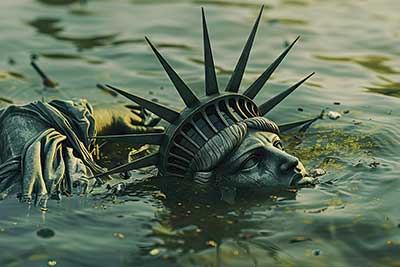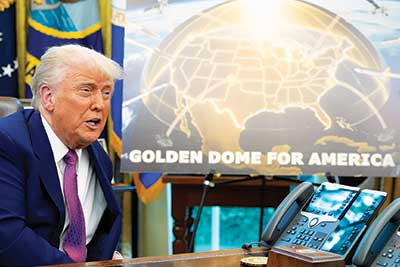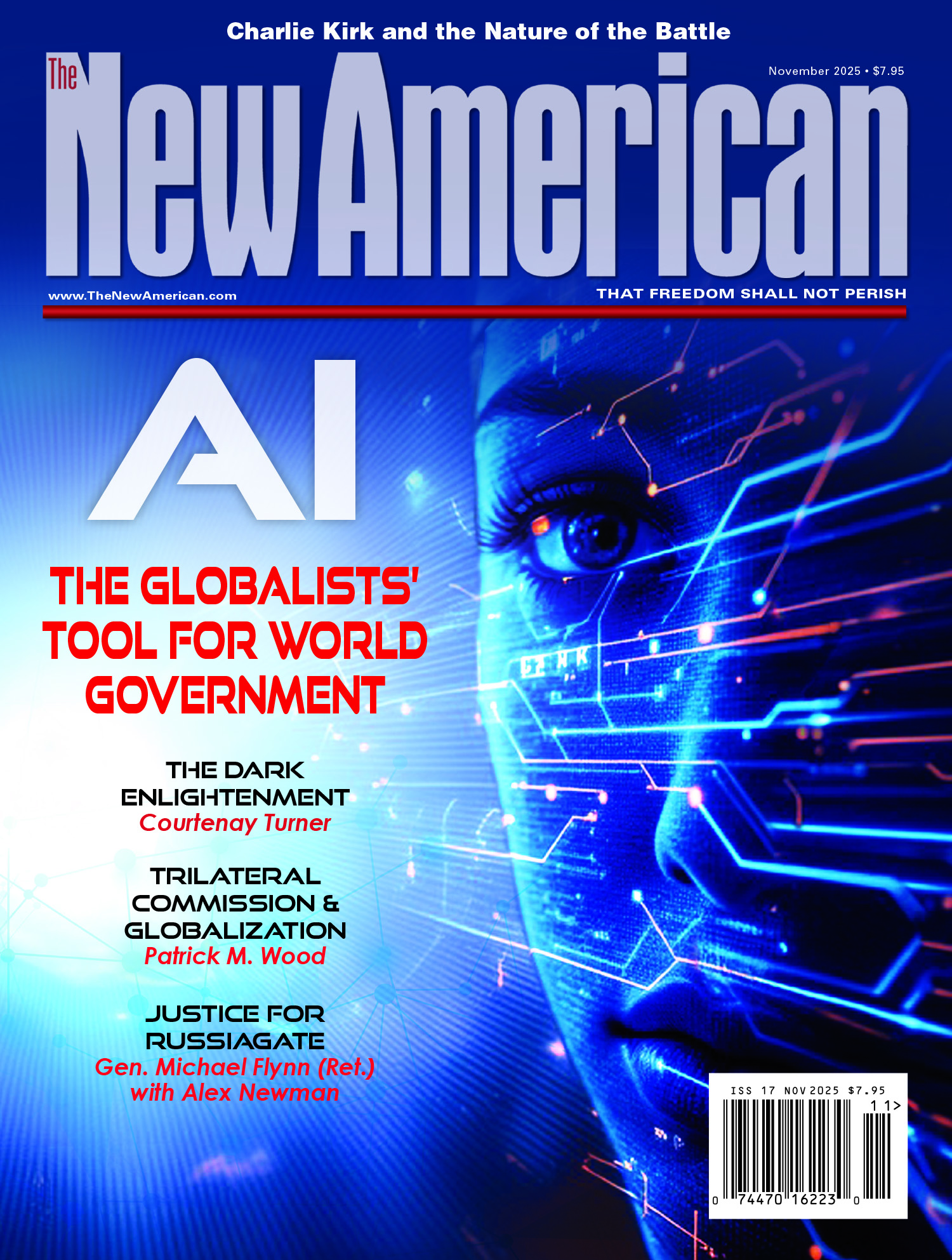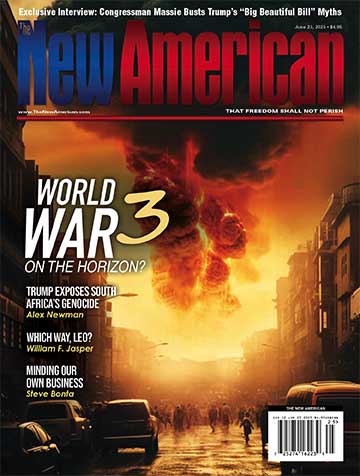World War III on the Horizon
On May 7, 2025, India and Pakistan went to war. Indian forces unleashed a barrage of missiles at targets inside Pakistan in reprisal for a bloody terrorist attack on Indian tourists in disputed Kashmir. In the three days of fighting that followed, India and Pakistan traded blows, with missiles raining down on both sides of the border. Several military aircraft were shot down, and religious sites were attacked. As the three days of intense fighting unfolded, the world watched and wondered how far events would go. After all, both India and Pakistan have nuclear arsenals, and this was one of only a handful of occasions when nuclear-armed foes had actually gone to war.
Three days into the conflict, something changed. The Trump administration, having previously declared the conflict “none of our business,” announced a hastily negotiated ceasefire, and India and Pakistan backed off. As it turned out, Pakistan, outgunned by its much larger neighbor, had drawn the United States into the conflict to provide diplomatic cover for a stand-down. And to do that, it played a calculated and brazen game of nuclear chicken.
According to Manoj Gupta of CNN-News18:
Following precision Indian military strikes under “Operation Sindoor,” Pakistan convened its National Command Authority (NCA) — the body responsible for its nuclear arsenal. During the meeting, Pakistan Army Chief General Asim Munir reportedly told US Senator Marco Rubio about Islamabad’s intent to “press the nuclear button” if the situation continued to spiral.
This veiled threat was part of a calculated strategy to trigger US intervention. Within hours of the NCA meeting, calls were made to New Delhi and a ceasefire was hastily announced, ending over 100 hours of military action between the two nuclear-armed neighbours.
In an unprecedented admission, a senior Pakistani military official told journalists, “We threatened America to stop the war or we would press the button.”…
This direct acknowledgement of nuclear blackmail has shocked strategic observers, highlighting how Pakistan weaponized global fears of nuclear conflict to pressure the U.S. and shape the outcome of the India-Pakistan confrontation.
Pakistan’s nuclear bluff is far from the only such that we have seen in recent years. Russia’s Putin has been threatening Europe with nuclear annihilation with almost monotonous regularity since the war on Ukraine began, while North Korea has periodically promised to unleash nuclear hellfire against South Korea if provoked. Throw in the prospect of an eventual nuclear Iran, and the world appears to be closer than ever to a long-dreaded World War III, complete with nukes, fallout, and the end of modern civilization as we know it.
That, at least, is the narrative. While the actors have changed over the decades, the warnings of nuclear annihilation have remained the same. However, the world has never actually witnessed a nuclear war — that is, an exchange of nuclear weapons under conditions of total war. And as long as the use of nuclear weapons remains the ultimate taboo, the threat of what might happen in the event World War III breaks out can be used as a powerful instrument of persuasion in global power politics.
Powder keg: Kashmir, India’s only Muslim-majority state, has long been the chief bone of contention between India and Pakistan. So far, President Trump’s only successful peace negotiation in his second term was persuading the two nuclear-armed nations to back away from the precipice of all-out war in the wake of a terror attack against Indian tourists in Kashmir. (AP Images)

False Alternatives
In 1947, philosopher James Burnham published The Struggle for the World, in which he argued for the need to establish a “world empire” along American federalist lines — because nuclear weapons left humanity with only two choices: conquest by the Soviet Union, or conquest by the United States.
Wrote Burnham:
The communist plan for the solution of the world crisis is the World Federation of Socialist Soviet Republics: that is, the communist World Empire. If the communists are not to win, there must be presented to the governments and the peoples of the world a positive alternative to the communist plan, which will meet, at least as well as the communist plan, the demands of the crisis. Mankind will not accept, as a substitute for the communist Empire, nothing.
This alternative can only be another, a non-communist World Federation — a federation at least of enough of the world to dominate effectively the major questions of world politics. No world federation will, we have seen, be attained voluntarily in our time. Besides the communists, only the United States holds power enough to force a federation into being. It can be brought about only if the United States, retaining for itself monopoly control of atomic weapons, assumes responsibility for world leadership….
The only alternative to the communist World Empire is an American Empire which will be, if not literally worldwide in formal boundaries, capable of exercising decisive world control…. The threat of a communist World Empire would therefore be eliminated. Once functioning, the primary political business of the American Empire would be the restriction of warfare within limits that would permit civilization to continue. To accomplish this, the crucial step would be to safeguard the monopoly of atomic weapons. There would have to be the continuous assurance against possession of atomic weapons or their means of manufacture by two or more rival centers; there would have always to be one and only one control.
The goal of a global monopoly over nuclear weapons has yet to be accomplished, and many other countries have acquired “nukes” since Burnham’s aspirational book was published. It needs to be pointed out that Burnham’s globalist Establishment credentials were impeccable. A prominent Trotskyite radical as a young man, Burnham resigned from the American Marxist movement in 1940, just in time to enlist his energies at the OSS (the predecessor to the CIA) following a recommendation from American diplomat George Kennan, where he was an expert on psychological warfare. After the war, Burnham allied himself with the new American conservative movement and, as a close associate of William F. Buckley, was one of the co-founders of National Review, where for many years he authored a column entitled “Third World War.” Thus Burnham’s views on the subject of nuclear weapons, World War III, and globalist strategy generally may be regarded as typical of those of the internationalists of his day and ours, to wit: 1) a “world empire” is inevitable, and far better for it to be constructed on Western, America-centered lines than at the behest of the Russians or the Chinese; and 2) nuclear weapons make any prospect of another world war inadmissible, so these weapons must all be either eliminated or brought under some type of monopolistic control — preferably the American hegemon, acting as agent for the globalists.
For decades, Western globalists on both the “Left” and the “Right” have encouraged the belief that the prospect of a war of extinction overrides all other principles and policy considerations, including even American independence. According to globalist logic, America is only justified in defending herself until the enemy calls her bluff and threatens to start a nuclear war. Once that happens, it’s time to surrender. Like the “better red than dead” arguments urged on the United States during the Cold War, these self-defeating cadences amount to preemptive capitulation in the face of a supposedly unopposable threat.
By all evidence, globalist elites would prefer to avoid World War III, understanding (as do the rest of us) that such an event would be immensely destructive, likely far surpassing the combined toll of the two previous world wars, and quite possibly irradiating vast regions of the earth, to the detriment of life forms generally. Some of the more extravagant predictions of a nuclear holocaust assert irrevocable damage to the world’s climate (so-called nuclear winter), mass extinction, extensive mutation among surviving organisms, and possibly even the near-extermination of the human race. Certainly such nightmarish outcomes had some plausibility during the height of the Cold War, when the United States and the Soviet Union had more than 60,000 nuclear weapons between them. Today’s nuclear stockpiles, however, are much smaller, with the United States and Russia fielding a combined 10,000 nukes, and the other seven nuclear powers adding as many as 1,500 total additional weapons. Still, the threat of such a war has proven devastatingly effective over the decades in extracting concessions from the United States and other countries that would oppose the effort to bring about “global integration,” i.e., some form of world government. As G. Edward Griffin long ago put it:
Without a doubt, the Atomic Bomb is the most powerful weapon in the Communist arsenal. But it’s as a psychological weapon, not a military one…. Under the constant threat of nuclear annihilation, we’ve accepted concessions, compromises, and defeats one after another, which would have been unthinkable without that spectre of a giant mushroom cloud fixed deep in our subconscious. As a matter of fact, The Bomb, as a psychological weapon, is being dropped on the American people every single day. Movies such as On the Beach, Seven Days in May, Dr. Strangelove, Fail Safe, Planet of the Apes — those well-produced and entertaining movies have done really a professional job of strengthening, subconsciously at least, the premise of The Grand Design [i.e, the plan to bring about world government].
In our day, of course, the steady parade of post-apocalyptic fiction continues to stoke popular paranoia about World War III; more recent cinematographic offerings such as The Road (based on a Cormack McCarthy novel of the same name), The Book of Eli, the Terminator movies, Homestead, and the television series Jericho, among many others, all contemplate a post-apocalyptic world devastated by nuclear war. The tropes have become so standard as to be cliché: roving bands of mutants, cannibals, and warlords in violent competition for scarce resources in a post-urban world where familiar icons such as the Statue of Liberty and the towers of Las Vegas are falling into ruin.

Liberty submerged: World War III would almost certainly desolate entire cities, but would American liberty and independence even survive such an event? (Lila Patel/Adobe Stock)
The Path to World War
But what would a hypothetical World War III actually look like? First of all, it is extremely unlikely that it would erupt completely by surprise on an unsuspecting world like the AI-generated nuclear holocaust in the Terminator movies. Instead, like most major wars, including the two previous world wars, it would likely break out in response to long-simmering regional conflicts or other triggers such as a major global financial crisis. Consider the lead-up to World War II, obvious with the benefit of hindsight but reasonably evident even in the 1930s to discerning observers. The dials for that conflict were set, in Europe at least, with the punitive peace imposed on Germany at Versailles, a peace that led to the financial ruin of Germany and the decrepit Weimar Republic. By the time of the rise of Adolf Hitler and the Nazis in the early 1930s, it was already obvious that something had gone terribly wrong in Germany. Hitler’s plans to rebuild the German military and to avenge her perceived humiliation were hardly a secret. At the same time, Stalin was busy committing genocide against Ukraine and cozying up to the Nazis, culminating in the Molotov-Ribbentrop Pact of 1939, which paved the way for the Soviet annexation of the Baltics and a large part of Finland shortly thereafter. And Italy’s Mussolini, having first formalized the Axis agreement with Germany in 1936, followed with the “Pact of Steel” in May 1939.
Meanwhile, the Far East had already been at war for several years, with the Second Sino-Japanese War taking a decisive turn with the Battle of Shanghai in 1937 and the appalling Nanjing Massacre at the end of that same pivotal year. In September 1940, in a bid to discourage America from joining the war on either front, Japan and Germany entered into the Tripartite Pact, an action that officially transformed the wars in Europe and the Far East into one titanic global conflict.
In other words, World War II did not break out in an instant but instead coalesced, and surprised no sober observer in its day.
The parallels between the world of the late 1930s and the world of today are significant and alarming. For example, one world power that (at least, according to its version of events) was humiliated by duplicitous Western powers — Russia — is now, under the leadership of Vladimir Putin, embarking on a revanchist campaign to reconstitute the Soviet Union, or at least a 21st-century simulacrum thereof. In some respects, Putin’s grievances, valid or not, are reminiscent of Hitler’s: In a time of weakness, he maintains, Russia was humiliated and taken advantage of by the Cold War victors, who — after promising to respect the Russian sphere of influence — proceeded to bring most former Eastern Bloc countries into NATO and the EU, and are bidding fair to do the same with a former constituent state of the Soviet Union, Ukraine. Now Putin is seeking to reincorporate (at least part of) Ukraine into Russia by force, and Europeans are worried that, following the annexation of Ukraine, he may move on to the Baltics and Poland, bringing Russia into direct confrontation with NATO.
In the Far East, meanwhile, China has embarked on an almost nonstop campaign of direct confrontation with four of its neighbors — India, Japan, the Philippines, and, especially, Taiwan. Communist China’s undisguised ambition to conquer Taiwan is well known; less appreciated are its extensive territorial claims on parts of the Philippines, especially the island of Palawan; most of Himalayan India; and the entirety of the small country of Bhutan, among others. China continues to nurse bitter grievances for the alleged “Century of Humiliation” imposed by the likes of the British and Imperial Japan, a theme that the communists have been exploiting for propaganda purposes for generations.
But for all its posturing and threats, China has not — so far — shown anything like the extraterritorial aggression of Imperial Japan, which, it must be remembered, controlled much of China, most of Southeast Asia, and most of the Western Pacific at the height of its power.
Then there’s the ever-volatile Middle East, where the issue du jour is Iran’s growing nuclear capacity. The United States seems likely to intervene there, inasmuch as a nuclear-armed Iran would not only pose a direct threat to the United States, but also very likely lead to a nuclear-armed Saudi Arabia, Turkey, and UAE in short order. Given Iran’s close ties with both Russia and China, it is conceivable that an all-out attack on Iran to deny them nuclear weapons might draw in other great powers.
In all of this, Trump’s attempts at ending these wars have been (with the exception of India and Pakistan) unsuccessful so far. Russia and Ukraine show no signs of a letup, and neither does the mess in the Middle East. Throw in the ongoing crisis between nuclear-armed India and Pakistan, along with the ever-volatile Korean peninsula, and there appears to be greater potential for nuclear conflict, as well as an all-out world war, than at any time since 1945, including the Cuban Missile Crisis of 1962.
Hidden Agendas
But wars — especially world-altering conflicts — seldom come about completely by accident. In particular, the involvement of the United States in war has often, if not always, been the result of deliberate maneuvering by elite interests whose agendas differ sharply from public perceptions. American involvement in World War I, for example, was promoted by the Woodrow Wilson administration as a crusade on behalf of “democracy.” But in reality, it was largely driven by international bankers anxious for a return on their investment after debtor nations such as France and the U.K., stretched to the limit of their ability to service their war debts, faced the prospect of both defeat and default. The American intervention ensured that the assets of big international lenders on both sides of the Atlantic were secured.
And there was another, even more sinister, motive. By the early 20th century, the movement to create a world government under an Anglo-American federation, directed by American and British elites, was well underway, as historian Carroll Quigley amply documented in his magnum opus Tragedy and Hope, and in even greater detail in his lesser-known volume The Anglo-American Establishment. This carefully conceived plan for a world federation was well known then, although it was carefully concealed from the general public. And it was still in the works after World War II, as the aforementioned James Burnham makes clear:
The supreme policy formulated in this chapter would, I believe, dictate an immediate proposal by the United States to Great Britain and the British Dominions: common citizenship and full political union…. Political experience, moreover, would seem to indicate that there would be more support for, and less opposition to, a proposal for outright union than for a mere alliance…. Actual union between the United States and Great Britain and her Dominions would … be a catalyst which would instantaneously transform the whole of world politics.
Both world wars cemented in the American psyche the notion that, after all, we should be re-yoked to Europe, and, especially, to the “perfidious Albion” we once opposed in two bitter conflicts to vindicate our independence. It is because of those wars that we are now involved in NATO and the UN; that we are treaty-bound to protect the likes of Japan, the Philippines, South Korea, Australia, and New Zealand; and that we have military bases all over the world to enforce the postwar global order that has included keeping the communist powers in check and ensuring that shipping lanes stay open and that international trade remains unhindered.
Now, however, the old order is fraying. For the first time in almost a century, the United States is expressing reservations at being enlisted to solve a major European conflict. Europeans are expressing growing dissatisfaction with the unwillingness of the United States to continue to foot most of the bill for defending the Continent. In both the Middle and Far East, America seems less interested in military domination than in reconfiguring international trade. To be sure, American military bases in Germany, Turkey, Japan, and South Korea remain open. But the zest for perpetuating world order has all but disappeared.
Nightmare Scenario
In such a time of transition, another world war is certainly a possibility — especially if it can be undertaken in such a way as to draw America back into the globalist fold. While it is impossible to know what the globalists are planning — or, indeed, the extent to which any of the current mayhem is the result of happenstance or malice aforethought — we can imagine how World War III might break out, and what its aftermath might look like. The initial spark might come on the Korean Peninsula, or in the South China Sea, the Middle East, the Suwalki Gap on the Poland-Lithuania border, or somewhere else. Whatever the catalyst, the United States at some point finds itself preparing for war with China, while the Middle East dissolves into all-out war. Russia and Belarus decide to take advantage of the distractions to move on the Baltic states and Poland, calculating that NATO no longer has the resolve or the resources to invoke Article 5, its mutual-defense clause. Hardened by years of fighting in Ukraine, Russian and Belarussian forces quickly overwhelm Latvia, Lithuania, and Estonia, and secure a coveted land corridor to the crucial Kaliningrad exclave. In the Far East, American forces rush to the aid of either South Korea or Taiwan, and before long, Americans and Chinese are in direct conflict for the first time since the Korean War. In the Middle East, a beleaguered Israel, facing a well-armed and united front of Arab nations, realizes that its old ally, the United States, cannot come to its aid, and, out of desperation, unleashes its most feared weapon, the Jericho III nuclear missile, against the massed forces of its enemies, including strikes on critical military bases in Syria, Saudi Arabia, and Egypt.
With the nuclear genie finally unbottled, combatants elsewhere evaluate the damage and calculate their own chances. Seeing that the war continues in the Middle East, even with hundreds of thousands dead from the Israeli strikes, the Chinese — whose inexperienced conventional forces are not faring well against the United States — decide to play their own nuclear trump card. A surprise nuclear barrage against major American military assets in the region, including bases in Guam, Japan, South Korea, and Japan, inflicts massive losses on U.S. forces, even though some of the missiles and nuclear-armed bombers are intercepted. The United States, having suffered a nuclear attack against its own territory, retaliates against China with an overwhelming attack on Chinese military assets and critical infrastructure on the mainland. Although civilian population centers are not deliberately targeted, the toll is still horrific.
In Europe, meanwhile, the toll is even worse, as Western European forces are targeted by Russian battlefield nukes, only to respond in kind with strikes against the Russian homeland. Russia retaliates with nuclear attacks on major European population centers, including Paris, London, Birmingham, and Sheffield. While millions of people are dying in the horrific nuclear escalation, most of Europe’s elites, along with critical assets, are directing matters from hardened bunkers deep within the Alps, the Pyrenees, and the Jura.
Seeing the horror unfolding in Europe, the United States decides to intervene to stop Russia. Millions of Americans flee from major population centers as America and Russia begin targeting each other’s critical military assets in an attempt to blunt each other’s ability to retaliate. At the same time, American forces continue to pound China with both nuclear and conventional weapons. Its military shattered, China withdraws its designs on Taiwan and/or South Korea, and turns its forces inward in a final, desperate effort to quell mass rioting and revolt.
Russia now reaps the whirlwind as the combined remaining forces of NATO are brought to bear on her overextended military. In the end, Russia loses, but Europe and the United States have suffered tens of millions of casualties. Several American cities have been leveled by Russian and Chinese nukes, but most of the damage has been done to critical military assets such as major air bases, naval facilities, and nuclear missile silos. In the Middle East, too, the fighting winds down.
With more than 400 million dead worldwide, World War III has been a calamity like no other. While the worst predictions of nuclear winter and mass extinction have not come to pass, the survivors find themselves in a radically altered world of bankrupt governments, worthless money, and shattered chains of production. Famine and disease — in addition to radiation sickness — soon rear their ugly heads, and titanic civil unrest erupts around the world. Starvation, race rioting, and partisan strife on an immense scale claim millions of additional lives, both in America and overseas.
But now the bunkered elites of Europe and the United States emerge with their praetorian guards, and announce a plan to a planet on the brink. The time of sovereign states is past, they tell the rest of us. Humanity has survived this calamity — barely — but next time, it will not be so lucky. Accordingly, all remaining nuclear warheads and other major military assets are to be put under international command, so that never again will the world be menaced by nuclear annihilation. Both Russia and China, defeated and paralyzed by civil unrest, are in no condition to resist.
Safety dome: Trump’s proposed “Golden Dome” missile defense project, inspired by Reagan’s Strategic Defense Initiative, as well as Israel’s “Iron Dome,” is a long overdue measure to do one thing that the federal government is constitutionally required to do: defend the American homeland. That it has refused to do so for decades is a monstrous crime of omission perpetrated by America’s many domestic enemies. (AP Images)

A new international organization is announced to replace the decrepit United Nations. It is to be called the United Federation (UF), and it is, in effect, a federal world government. The United Federation will have a monopoly on military force and a new global currency, the bancor, which will replace all the currencies, including the U.S. dollar, that have been destroyed by the war and its aftermath. It is announced that all national and personal debts will be erased, and a global “jubilee year” of sorts is proclaimed, to enable the human race to rebuild. The UF will be headquartered in Atlanta, with regional administrative facilities all over the world. The United States relinquishes control of its major military bases around the world to the new UF military force. People are encouraged to restart and rebuild, but it is made clear to all that certain relics of the world that was will no longer be tolerated. Civilian arms are confiscated en masse, and a new global ID, allowing people to travel, live, and work wherever they desire, is issued. Large numbers of men and women, desperate for income, enlist to be trained for the new military and police forces of the UF, and, before long, the entire planet is under UF control. For a while, the new global masters appear benign, coordinating global decontamination efforts and the rebuilding of cities and roads. Commerce resumes and confidence in the new, simplified global financial system buoys the markets. Civil unrest is quelled by the UF, in coordination with elements of the old U.S. military, now subordinate to the new global authority. While some dissenters warn of a “New World Order,” most Americans — and citizens of other countries — are happy to see the world being put back together, and peace and prosperity restored. To the vast majority of traumatized survivors, the fact that the U.S. Constitution and the United States itself no longer exist is of little consequence.
Whether World War III follows this or some other scenario, it will likely involve the following elements:
• Global elites and government leaders will take preemptive steps to protect themselves, in order not only to ensure continuity of existing institutions, but also to have the wherewithal to effect radical changes in governance after the war’s conclusion.
• World War III would likely involve some use of nuclear weapons, but — owing to their limited supply and to rational wartime calculus — most of them will be directed against military assets in an attempt to deny the enemy retaliatory capability. The rapid development of an American “Golden Dome” missile shield, if successful in the near future, could also be a significant mitigating factor.
• World War III would likely compress into a few weeks a level of devastation and mortality surpassing the two previous world wars combined.
• World War III would impact the American homeland more than any conflict since the Civil War.
• The American populace would be traumatized, impoverished, and afflicted by mass starvation and disease.
• In the wake of such a conflict, many of the world’s wealthiest and most powerful, having survived the event, would agitate for a world government to replace the “failed” UN system. This would override both the Declaration of Independence and the U.S. Constitution. At first, a post-World War III global order might be welcomed for bringing about continuity and a civilizational rebuild, but in the long run it would be transformed into a global socialist dictatorship.
For all of these and numerous other reasons, we must do our utmost to ensure that World War III never happens — or that, if it does, the damage to America will be limited. Speedy construction of a credible missile defense is a laudable goal, ending decades of self-defeating platitudes about “mutually assured destruction” and “deterrence” via a “balance of terror.”
America needs to withdraw as expeditiously as possible from all internationalist, multilateral organizations, especially the United Nations and multilateral defense treaties such as NATO. Both the UN and NATO oblige us to go to war under specious pretexts, namely, the defense of borders and interests other than our own.
But if all else fails, and the worst comes to pass before sufficient preventive measures can be undertaken, American patriots must be prepared to confront a no-holds-barred campaign to usher in world government and renounce our national independence. While it is prudent to take steps to “prep” for such an event by storing food, ammunition, money, and the implements of survival, it is just as important to prepare for the inevitable postwar campaign to bring the United States irrevocably under global control. Our Constitution and way of life have weathered many storms, and can yet weather even the extremities of nuclear war, if our allegiance to our country and liberty is unshakable.


